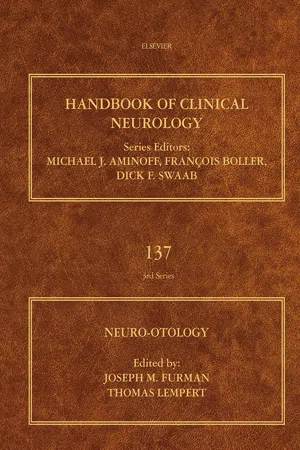
- 432 pages
- English
- ePUB (mobile friendly)
- Available on iOS & Android
About This Book
Neuro-Otology: a volume in the Handbook of Clinical Neurology series, provides a comprehensive translational reference on the disorders of the peripheral and central vestibular system. The volume is aimed at serving clinical neurologists who wish to know the most current established information related to dizziness and disequilibrium from a clinical, yet scholarly, perspective.
This handbook sets the new standard for comprehensive multi-authored textbooks in the field of neuro-otology. The volume is divided into three sections, including basic aspects, diagnostic and therapeutic management, and neuro-otologic disorders. Internationally acclaimed chapter authors represent a broad spectrum of areas of expertise, chosen for their ability to write clearly and concisely with an eye toward a clinical audience.
The Basic Aspects section is brief and covers the material in sufficient depth necessary for understanding later translational and clinical material. The Diagnostic and Therapeutic Management section covers all of the essential topics in the evaluation and treatment of patients with dizziness and disequilibrium. The section on Neuro-otologic Disorders is the largest portion of the volume and addresses every major diagnostic category in the field.
- Synthesizes widely dispersed information on the anatomy and physiology of neuro-otologic conditions into one comprehensive resource
- Features input from renowned international authors in basic science, otology, and neuroscience
- Presents the latest assessment of the techniques needed to diagnose and treat patients with dizziness, vertigo, and imbalance
- Provides the reader with an updated, in-depth review of the clinically relevant science and the clinical approach to those disorders of the peripheral and central vestibular system
Frequently asked questions
Anatomy, physiology, and physics of the peripheral vestibular system
* Correspondence to: Herman Kingma, Department of ORL and Head and Neck Surgery, Maastricht University Medical Centre, Maastricht, the Netherlands. email address: [email protected]
Abstract
Keywords
Introduction
General introduction to the labyrinth

Table of contents
- Cover image
- Title page
- Table of Contents
- Copyright
- Handbook of Clinical Neurology 3rd Series
- Foreword
- Preface
- Contributors
- Chapter 1: Anatomy, physiology, and physics of the peripheral vestibular system
- Chapter 2: Physiology of central pathways
- Chapter 3: Neurotransmitters in the vestibular system
- Chapter 4: Multisensory integration in balance control
- Chapter 5: The epidemiology of dizziness and vertigo
- Chapter 6: Vestibular symptoms and history taking
- Chapter 7: Bedside examination
- Chapter 8: Eye movements in vestibular disorders
- Chapter 9: The caloric irrigation test
- Chapter 10: Vestibular-evoked myogenic potentials
- Chapter 11: Audiometry and other hearing tests
- Chapter 12: Rotational testing
- Chapter 13: An overview of vestibular rehabilitation
- Chapter 14: Principles of vestibular pharmacotherapy
- Chapter 15: Acute unilateral loss of vestibular function
- Chapter 16: Chronic unilateral vestibular loss
- Chapter 17: Bilateral vestibulopathy
- Chapter 18: Benign paroxysmal positional vertigo and its variants
- Chapter 19: Menière's disease
- Chapter 20: Otologic disorders causing dizziness, including surgery for vestibular disorders
- Chapter 21: Posttraumatic dizziness and vertigo
- Chapter 22: Vestibular migraine
- Chapter 23: Ischemic syndromes causing dizziness and vertigo
- Chapter 24: Functional and psychiatric vestibular disorders
- Chapter 25: Vertigo and dizziness in children
- Chapter 26: The conundrum of cervicogenic dizziness
- Chapter 27: Motion sickness
- Chapter 28: Mal de débarquement syndrome
- Index